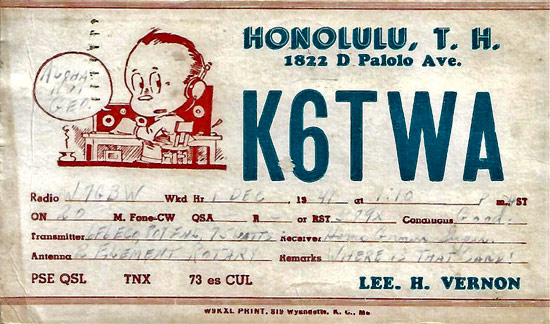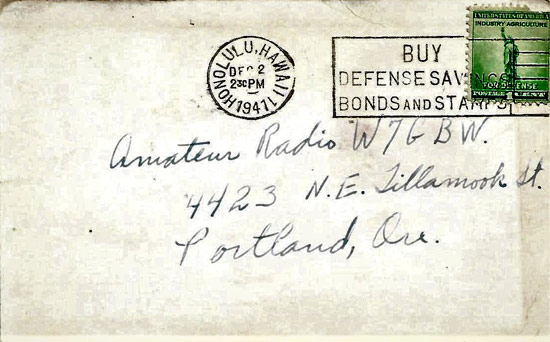


K6TWA 1941 Honolulu, Hawaii
Operator: Lee H. Vernon
Notice the date on the reverse
side of the card, December 2, 1941.
That is 6 days before the United States entered World War II as
Congress declared war against Imperial Japan on December 8th, a
day after the attack on Pearl Harbor.
I recently noted that your
web site displays, as an historical item in your HAM gallery, my
father's (Lee H. Vernon) first HAM QSL card from Hawaii dated 2
Dec. 1941. I thought you might enjoy a little of my
father's history. My father grew up dirt poor in Colorado
and Texas, didn't even graduate high school, and was taken down
to the U.S. Navy recruiter by my grandfather during the
depression in 1932. My grandfather told him he had to
enlist because there weren't any jobs for him in Texas.
Following a couple of enlisted years in the Navy doing this and
that, he became a Radioman "Striker" on board a
battleship and advanced quickly - No high school degree but he
wasn't stupid! In 1941, the time period of the QSL card, he
was a Radioman 1st Class stationed at the Wahiwa Navy
Communications site on Oahu. It's historically interesting
that the QSL card is dated 1 Dec. 1941. My father was on
duty at the key that fateful Sunday morning, 7 Dec. 1941 when the
Japanese attacked Pearl Harbor. He had the distinction of
tapping out on the key the first Morse Code U.S. Navy
official communication of the Japanese attack to naval
headquarters in the Philippines. He had to send it three
times because they responded back with disbelief. The third
time, the message ended with "This is not a
drill". The other Radioman, Don Tracy, who sat next to
him sent out the first official message to naval command in the
United States. Don's name has been documented in historical
documents but my father's was not. He was soon transferred
back to San Diego with my mother and my infant older
brother. He was promoted to Chief Radioman in 1942.
The rest of his WW2 time was spent in communications operations
supporting Navy Amfib operations out of San Diego to Adak, Alaska
and all over the pacific war theater. In 1943, he applied
to become a Warrant Officer and to his surprise, they
commissioned him as an line Ensign. While on the USS Mt.
McKinley (AGC-7), he handled all command communications and
U.S. war correspondents went through him to dispatch their
reports. He was friends with Ernie Pyle and had a lot of
respect for him because Ernie sought out the real stories of the
soldiers and sailors and he didn't just hang around the Admirals
and Generals looking for a scoop. He was on the first U.S.
Navy ship into the Hiroshima harbor and was on the ground a
few weeks after the atomic blast, only officers were allowed
ashore. He stood on the deck of the USS Missouri when the
Japanese signed the surrender documents in 1945. Following
WW2, he was again the communications officer on the Mt. McKinley
during the Korean Conflict. Between and after wars, my dad
filled a number of administrative positions at various Navy
communication bases, including a return to Adak as Executive
Officer at the Clam Lagoon NAVCOMMSTA In the mid-1950s (I was
there too!) where he was promoted to his final rank of
LCDR. He retired in 1958 with 26 years of enlisted to
"Mustang" commissioned officer service from a posting
as OIC at Cheltenham Naval Radio Station in rural Maryland.
My father enjoyed a relaxed retirement in Oregon where he could
hunt with our beloved labrador retrievers and fish for
salmon. He held an electronics technician position up to
the mid 1980s at the University of Oregon where he designed,
built and maintained electronic devices used in scientific
research by the UO science departments. He was retired
more years than his military service and was in excellent
physical condition until he sadly passed away due to a fast
growing brain tumor in 1991.
He had a "HAM Shack" set up in the garage to his
dying day and had HAM buddies from all around the world.
Robert L. Vernon, CDR, Medical Service Corps, USNR (Retired).
QSL W4WJ Collection
Info courtesy of Robert L. Vernon